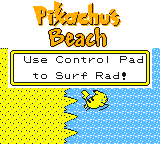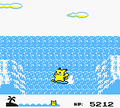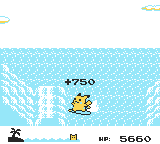Pikachu's Beach: Difference between revisions
(This article also needed some help. I believe we can still cut down more trivia and integrate it in other parts of the article but I'm not sure how (right now, at least).) |
(Surfing Pikachu is not relevant to the VC releases, and there have been no Surfing Pikachu distributions announced for the VC releases either, so that note is unnecessary.) |
||
| (22 intermediate revisions by 8 users not shown) | |||
| Line 1: | Line 1: | ||
[[File: | [[File:Pikachu Beach intro screen.png|thumb|The minigame's brief introductory screen]] | ||
'''Pikachu's Beach''' (Japanese: '''{{ | '''Pikachu's Beach''' (Japanese: '''{{j|ピカチュウのサマービーチ}}''' ''Pikachu's Summer Beach'') is a minigame exclusive to {{game|Yellow}} that requires a {{DL|Pikachu variants|Surfing Pikachu}} ([[Game Boy]]) or {{ga|Red's Pikachu|the starter Pikachu}} ([[Virtual Console]]). It is played at '''Summer Beach House''' (Japanese: '''{{j|うみのいえ}}''' ''Sea House'') on {{rt|19|Kanto}}, where the '''Surfin' Dude''' (Japanese: '''{{j|なみのりオヤジ}}''' ''Surfing Old Man'') lives. The {{pkmn|anime}} episode ''[[EP067|The Pi-Kahuna]]'' features this minigame. | ||
The only legitimate ways to obtain a Surfing Pikachu in Yellow are through {{eng|Pokémon Stadium}} or an {{DL|List of Nintendo event Pokémon with in-game effects|Pikachu|event distribution}}. | |||
==Gameplay== | |||
The goal of the minigame is to score as many points as possible. The player controls {{ga|Red's Pikachu|Pikachu}} using the [[Game Boy]]'s Control Pad. As Pikachu is launched over a wave, the left and right buttons can be pressed to cause Pikachu to flip. Bonus "rad" points may be granted for landing safely. | |||
== | The scoring system, measured in "Radness", is as follows: | ||
* One flip = 50 points | |||
* Two flips in the same direction = 150 points | |||
* Two flips in different directions = 180 points | |||
* Three flips in the same direction = 350 points | |||
* Three flips not all in the same direction = 500 points | |||
The HP counter (not to be confused with the {{stat|HP|HP stat}} of {{OBP|Pokémon|species}}) in the lower right corner acts as a timer and is constantly decreasing from 6000 HP. On the opposite side of this counter is a progress bar that shows how far Pikachu is from the shore. The game will finish once Pikachu reaches the shore. "Radness" along with remaining HP is then summed up to determine the final score. | |||
The | The game scroll rate will increase the more flips Pikachu manages to pull off successfully, which consequently increases the rate at which Pikachu reaches the shore. The scroll rate drops if Pikachu fails a flip and falls underwater. If the player runs out of HP before reaching the shore, the player loses. | ||
===Hi-score=== | |||
[[File:Pikachu Beach hi-score.png|thumb|A hi-score]] | |||
When the game is over, Pikachu is scored based on the remaining HP and "Radness". The hi-score is saved and can be recalled anytime by checking the printer in Summer Beach House and declining the game's request to issue a {{DL|Game Boy Printer|Printable features in Pokémon games|print}}. In the [[Game Boy]] releases, accepting the request will print a black-and-white copy of the hi-score through the [[Game Boy Printer]]. | |||
{{clear}} | |||
==Regional differences== | |||
If the game is played on a [[Super Game Boy]] or [[Game Boy Color]], {{ga|Red's Pikachu|Pikachu}}'s cheeks appear blue due to the limited color palette of these consoles. In the Japanese Yellow, Game Boy Color mode only applies a yellow and red palette to the graphics in a similar fashion to the other [[Generation I]] games, whereas the localizations use palettes with more saturated colors than those of Super Game Boy mode. As a result, Pikachu's cheeks are depicted properly in the Game Boy Color mode of the Japanese version. | |||
<gallery> | |||
Pikachu Beach SGB mode.png|Western Yellow (Super Game Boy mode) | |||
Pikachu Beach SGB mode JP.png|Japanese Yellow (Super Game Boy mode) | |||
Pikachu Beach.png|Western Yellow (Game Boy Color mode) | |||
Pikachu Beach GBC mode JP.png|Japanese Yellow (Game Boy Color mode) | |||
</gallery> | |||
==Trivia== | ==Trivia== | ||
[[File:Pikachu's Beach Unused Bonus.png|thumb|The unused bonus]] | |||
* In {{g|Snap}}, a {{p|Pikachu}} on the | * In {{g|Snap}}, a {{p|Pikachu}} on the {{FB|Pokémon Island|Beach}} level can be lured onto a {{wp|surfboard}}. In {{g|Battle Revolution}}, it is possible to obtain a Pikachu that knows {{m|Surf}} and uses a surfboard in-game. | ||
* The music theme for Pikachu's Beach is stored on a soundbank which doesn't exist in the previous [[core series]] [[Generation I]] games, along with the [https://www.youtube.com/watch?v=Bl-gTlqI3lc Rocket Duo encounter], [https://www.youtube.com/watch?v=xMqEtddtSbs Print], and [https://www.youtube.com/watch?v=GFGCRxmqMkA unused themes]. | |||
* The music theme for Pikachu's Beach is stored on a soundbank which doesn't exist in the previous [[ | * There is an [[Pokémon Yellow beta#Unused Pikachu's Beach bonus|unused 750-point "Radness" bonus]] programmed in the game. It does not appear to be achievable in-game by any method other than hacking. | ||
* There is | * The gameplay of this minigame is similar to the popular [[Nintendo Entertainment System|NES]] game {{wp|Excitebike}}. | ||
* The gameplay of this minigame is similar to the popular | {{clear}} | ||
{{Project Games notice}} | |||
[[Category:Pokémon Yellow]] | [[Category:Pokémon Yellow]] | ||
[[Category:Minigames]] | |||
[[de:Pikachus Strand]] | [[de:Pikachus Strand]] | ||
[[ja:ピカチュウのサマービーチ]] | [[ja:ピカチュウのサマービーチ]] | ||
Revision as of 16:15, 29 February 2016
Pikachu's Beach (Japanese: ピカチュウのサマービーチ Pikachu's Summer Beach) is a minigame exclusive to Pokémon Yellow that requires a Surfing Pikachu (Game Boy) or the starter Pikachu (Virtual Console). It is played at Summer Beach House (Japanese: うみのいえ Sea House) on Route 19, where the Surfin' Dude (Japanese: なみのりオヤジ Surfing Old Man) lives. The anime episode The Pi-Kahuna features this minigame.
The only legitimate ways to obtain a Surfing Pikachu in Yellow are through Pokémon Stadium or an event distribution.
Gameplay
The goal of the minigame is to score as many points as possible. The player controls Pikachu using the Game Boy's Control Pad. As Pikachu is launched over a wave, the left and right buttons can be pressed to cause Pikachu to flip. Bonus "rad" points may be granted for landing safely.
The scoring system, measured in "Radness", is as follows:
- One flip = 50 points
- Two flips in the same direction = 150 points
- Two flips in different directions = 180 points
- Three flips in the same direction = 350 points
- Three flips not all in the same direction = 500 points
The HP counter (not to be confused with the HP stat of Pokémon) in the lower right corner acts as a timer and is constantly decreasing from 6000 HP. On the opposite side of this counter is a progress bar that shows how far Pikachu is from the shore. The game will finish once Pikachu reaches the shore. "Radness" along with remaining HP is then summed up to determine the final score.
The game scroll rate will increase the more flips Pikachu manages to pull off successfully, which consequently increases the rate at which Pikachu reaches the shore. The scroll rate drops if Pikachu fails a flip and falls underwater. If the player runs out of HP before reaching the shore, the player loses.
Hi-score
When the game is over, Pikachu is scored based on the remaining HP and "Radness". The hi-score is saved and can be recalled anytime by checking the printer in Summer Beach House and declining the game's request to issue a print. In the Game Boy releases, accepting the request will print a black-and-white copy of the hi-score through the Game Boy Printer.
Regional differences
If the game is played on a Super Game Boy or Game Boy Color, Pikachu's cheeks appear blue due to the limited color palette of these consoles. In the Japanese Yellow, Game Boy Color mode only applies a yellow and red palette to the graphics in a similar fashion to the other Generation I games, whereas the localizations use palettes with more saturated colors than those of Super Game Boy mode. As a result, Pikachu's cheeks are depicted properly in the Game Boy Color mode of the Japanese version.
Trivia
- In Pokémon Snap, a Pikachu on the Beach level can be lured onto a surfboard. In Pokémon Battle Revolution, it is possible to obtain a Pikachu that knows Surf and uses a surfboard in-game.
- The music theme for Pikachu's Beach is stored on a soundbank which doesn't exist in the previous core series Generation I games, along with the Rocket Duo encounter, Print, and unused themes.
- There is an unused 750-point "Radness" bonus programmed in the game. It does not appear to be achievable in-game by any method other than hacking.
- The gameplay of this minigame is similar to the popular NES game Excitebike.

|
This game-related article is part of Project Games, a Bulbapedia project that aims to write comprehensive articles on the Pokémon games. |






